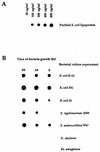Lipoprotein release by bacteria: potential factor in bacterial pathogenesis
- PMID: 9784522
- PMCID: PMC108648
- DOI: 10.1128/IAI.66.11.5196-5201.1998
Lipoprotein release by bacteria: potential factor in bacterial pathogenesis
Abstract
Lipoprotein (LP) is a major component of the outer membrane of bacteria in the family Enterobacteriaceae. LP induces proinflammatory cytokine production in macrophages and lethal shock in LPS-responsive and -nonresponsive mice. In this study, the release of LP from growing bacteria was investigated by immuno-dot blot analysis. An immuno-dot blot assay that could detect LP at levels as low as 100 ng/ml was developed. By using this assay, significant levels of LP were detected in culture supernatants of growing Escherichia coli cells. During mid-logarithmic growth, approximately 1 to 1.5 microgram of LP per ml was detected in culture supernatants from E. coli. In contrast, these culture supernatants contained 5 to 6 microgram/ml of lipopolysaccharide (LPS). LP release was not unique to E. coli. Salmonella typhimurium, Yersinia enterocolitica, and two pathogenic E. coli strains also released LP during in vitro growth. Treatment of bacteria with the antibiotic ceftazidime significantly enhanced LP release. Culture supernatants from 5-h cultures of E. coli were shown to induce in vitro production of interleukin-6 (IL-6) by macrophages obtained from LPS-nonresponsive C3H/HeJ mice. In contrast, culture supernatants from an E. coli LP-deletion mutant were significantly less efficient at inducing IL-6 production in C3H/HeJ macrophages. These results suggest, for the first time, that LP is released from growing bacteria and that this released LP may play an important role in the induction of cytokine production and pathologic changes associated with gram-negative bacterial infections.
Figures








Similar articles
-
Bacterial lipoprotein and lipopolysaccharide act synergistically to induce lethal shock and proinflammatory cytokine production.J Immunol. 1997 Nov 15;159(10):4868-78. J Immunol. 1997. PMID: 9366412
-
Bacterial peptidoglycan-associated lipoprotein is released into the bloodstream in gram-negative sepsis and causes inflammation and death in mice.J Biol Chem. 2002 Apr 19;277(16):14274-80. doi: 10.1074/jbc.M109696200. Epub 2002 Feb 5. J Biol Chem. 2002. PMID: 11830585
-
Lipoprotein from Yersinia enterocolitica contains epitopes that cross-react with the human thyrotropin receptor.J Immunol. 1997 Feb 15;158(4):1976-83. J Immunol. 1997. PMID: 9029141
-
Evidence for antibiotic-mediated endotoxin release as a contributing factor to lethality in experimental gram-negative sepsis.Scand J Infect Dis Suppl. 1996;101:3-8. Scand J Infect Dis Suppl. 1996. PMID: 9060044 Review.
-
Long-chain fatty acids as nutrients for Gram-negative bacteria: stress, proliferation, and virulence.Curr Opin Microbiol. 2025 Jun;85:102609. doi: 10.1016/j.mib.2025.102609. Epub 2025 Apr 18. Curr Opin Microbiol. 2025. PMID: 40252293 Review.
Cited by
-
Less is more! Low amount of Fusobacterium nucleatum supports macrophage-mediated trophoblast functions in vitro.Front Immunol. 2024 Aug 8;15:1447190. doi: 10.3389/fimmu.2024.1447190. eCollection 2024. Front Immunol. 2024. PMID: 39176096 Free PMC article.
-
Atorvastatin increases the production of proinflammatory cytokines and decreases the survival of Escherichia coli-infected mice.Sci Rep. 2019 Aug 12;9(1):11717. doi: 10.1038/s41598-019-48282-2. Sci Rep. 2019. PMID: 31406240 Free PMC article.
-
Vesicle-independent extracellular release of a proinflammatory outer membrane lipoprotein in free-soluble form.BMC Microbiol. 2008 Jan 28;8:18. doi: 10.1186/1471-2180-8-18. BMC Microbiol. 2008. PMID: 18226201 Free PMC article.
-
Macrolides Decrease the Proinflammatory Activity of Macrolide-Resistant Streptococcus pneumoniae.Microbiol Spectr. 2023 Jun 15;11(3):e0014823. doi: 10.1128/spectrum.00148-23. Epub 2023 May 16. Microbiol Spectr. 2023. PMID: 37191519 Free PMC article.
-
Haemophilus influenzae porin contributes to signaling of the inflammatory cascade in rat brain.Infect Immun. 2001 Jan;69(1):221-7. doi: 10.1128/IAI.69.1.221-227.2001. Infect Immun. 2001. PMID: 11119509 Free PMC article.
References
-
- Andersen B M, Solberg O. The endotoxin-liberating effect of antibiotics on meningococci in vitro. Acta Pathol Microbiol Scand Sect B. 1980;88:231–236. - PubMed
-
- Berkowitz F E, Vallabh P, Altman D I, Diamantes F, VanWyk H J, Stroucken J M. Jarisch-Herxheimer reaction in meningococcal meningitis. Am J Dis Child. 1983;137:599–603. - PubMed
-
- Bessler W G, Resch K, Hancock E, Hantke K. Induction of lymphocyte-proliferation and membrane changes by lipoprotein derivatives of the lipoprotein from the outer membrane of E. coli. Z Immunitaetsforsch. 1977;153:11–19. - PubMed
-
- Bessler W G, Ottenbreit B P. Studies on the mitogenic principal of lipoprotein from the outer membrane of E. coli. Biochem Biophys Res Commun. 1977;76:239–246. - PubMed
MeSH terms
Substances
LinkOut - more resources
Full Text Sources
Other Literature Sources

